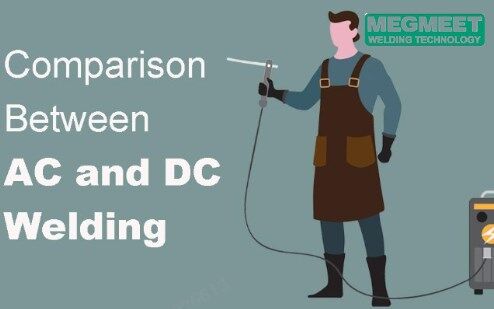In the world of welding, the debate between AC and DC stick welding has long been a topic of discussion among professionals and hobbyists alike. With advancements in welding technology, understanding the differences between these two methods is crucial for achieving optimal results. Whether you're working on a heavy-duty industrial project or a precision-based task, choosing the right welding technique can significantly impact efficiency, quality, and cost.
In this article, we’ll delve into the specifics of AC stick welding and DC stick welding, exploring their unique advantages, applications, and how to decide which one suits your welding requirements. If you're looking for a DC welding machine for sale or curious about the AC welding machine price, this guide will provide you with valuable insights to make informed decisions.

I. What is DC Stick Welding?
DC stick welding employs direct current (DC) that flows consistently in one direction. Known for its smoother and more stable arcs, this method is often preferred for applications requiring precision and deeper weld penetration.
Advantages of DC Stick Welding:
Enhanced Control and Stability: DC stick welding offers superior control and stability during the welding process. The consistent flow of current in one direction enables smoother arcs, resulting in precise and controlled welds.
Precision on Thinner Materials: This welding method is ideal for welding thinner materials. It provides deeper penetration while maintaining better control, resulting in cleaner and stronger welds on thinner metals.
Deeper Weld Penetration: DC welding facilitates deeper weld penetration compared to AC welding. The consistent flow of current allows for stronger fusion between metals, enhancing weld quality and strength.
Minimal Spatter and Cleaner Welds: Due to its smoother arc characteristics, DC stick welding produces minimal spatter. This results in cleaner welds, reducing the need for post-weld clean-up and ensuring a neater final product.
Suitability for Welding Alloys: DC welding is particularly suitable for welding various alloys, including stainless steel and aluminum. Its precision and control make it well-suited for producing high-quality welds on these materials.
II. What is AC Stick Welding?
AC stick welding is a widely used welding technique that utilizes an alternating current (AC) to generate the welding arc. Unlike DC, the current alternates direction multiple times per second, creating a unique "cleaning action" that is particularly beneficial for certain types of materials and environments.
Advantages of AC Stick Welding:
Effective on Contaminated Metals: AC stick welding excels in handling contaminated or rusted metals. The alternating current's inherent cleaning action helps remove surface impurities, making it ideal for welding on materials with dirt, rust, or coatings.
Suitability for Thick Materials: This welding method is well-suited for thicker materials. The robust arc stability provided by AC current allows for consistent and reliable welds on heavy or thick metals.
Adaptability to Challenging Environments: AC stick welding showcases resilience in adverse or outdoor conditions. Its stability in windy or less-controlled environments makes it a preferred choice for outdoor welding tasks.
Robust Arc Stability: The alternating current in AC stick welding generates a stable arc that withstands interruptions caused by surface contaminants or irregularities, ensuring a steady welding process.
Versatility in Magnetized Metals: AC welding handles magnetized metals adeptly. It effectively welds materials prone to magnetic interference, maintaining consistent arc stability for precise welding outcomes.
III. AC vs. DC Stick Welding: Key Differences
When deciding between AC and DC stick welding, it's essential to consider the specific requirements of your project. Below are the key differences to help you make an informed choice:
| Feature | AC Stick Welding | DC Stick Welding |
| Current Type | Alternating Current (AC) | Direct Current (DC) |
| Arc Stability | Robust, adaptable to contaminants | Smoother, more stable |
| Material Thickness | Best for thicker materials | Ideal for thinner materials |
| Weld Penetration | Moderate penetration | Deeper penetration |
| Environmental Adaptability | Excellent for outdoor or challenging conditions | Less adaptable to windy or outdoor environments |
| Spatter | Higher spatter | Minimal spatter |
IV. Choosing the Ideal Welding Machine
Selecting the right welding machine depends on your specific needs. Here’s a breakdown to guide your decision:
1) When to Choose DC Stick Welding:
Precision and Control: Opt for DC welding for projects requiring high precision, such as welding thinner materials or alloys.
Deeper Penetration: DC welding is recommended when deeper weld penetration is critical for the strength and durability of the weld.
Cleaner Welds: If minimal spatter and neater welds are a priority, DC welding is the way to go.
2) When to Choose AC Stick Welding:
Thicker or Rusted Metals: AC welding is ideal for welding thick materials or metals with surface contaminants.
Outdoor Welding: Its adaptability to challenging environments makes it perfect for fieldwork or outdoor projects.
Magnetized Metals: AC welding is the better choice for materials prone to magnetic interference.
Conclusion:
The choice between AC stick welding and DC stick welding isn’t about determining a clear winner but rather about selecting the best fit for your specific welding needs. Both methods have unique advantages, catering to diverse applications based on material properties, environmental conditions, and desired weld quality.
Whether you're in the market for a DC welding machine for sale or comparing the AC welding machine price, understanding the differences between these two techniques will help you make a more informed decision. By choosing the right welding method, you can achieve higher efficiency, better weld quality, and greater cost savings in the long run.
For high-quality welding machines tailored to your needs, visit Megmeet Welding Technology today. Explore our range of DC welding machines and AC welding machines designed to meet the demands of modern welding applications.
Related articles:
1. How to Improve Your Stick Welding Technique?
2. All You Need To Know About Overhead Stick Welding
3. Pros and Cons of Stick Welding and MIG Welding
4. What is the Difference Between Stick Welding and MIG Welding?
5. MMA "Stick" Welding: What is Open Circuit Voltage (OCV)?




